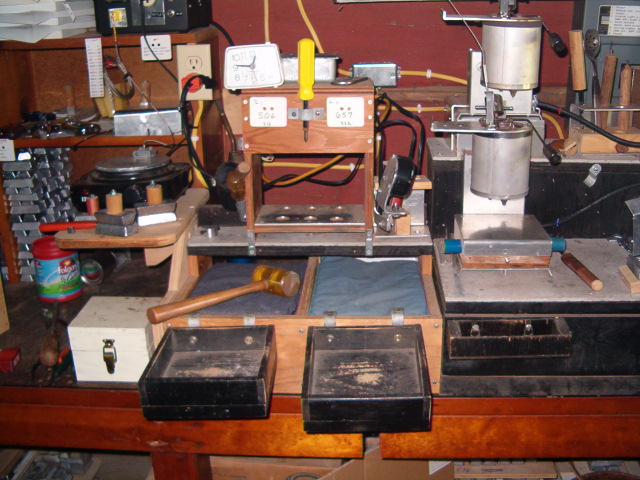Mike W1
Active Member
Don't know how valid statistically these little sessions are going to be but have done 8 or 10 short runs so far and am seeing some consistency in results. 80-100 casts with a Lyman DC 452370 mould each time and separating the bullets by cavity. Bottom pouring with stock steel sprue plate and also aluminum sprue plate alternately. Preheated the mould on a hot plate at 380° F for the the roughly 20 minutes it takes to get the pot up to temperature. Both units PID controlled. Have figured the Avg. weight and then the percentage that are within ± 1 gr. of that weight. Recorded the number of Highs & Lows of that average but only recorded the extremes of each category. There might have been 7 Higher than average and 2 Lower out of say 90 bullets. That would give me a 90% figure of that ± 1 gr variation which is what is recorded. Might not be the best way I suppose but can easily compare success in percentages. What seems apparent to me so far.
1. First cast bullets weigh right in the average per cavity for that session. 100%
2. Average weight seems to vary a couple tenths of a grain from session to session.
3. Bullets cast with the aluminum sprue plate are generally about a grain lighter than with the steel.
4. Better consistency with the Rear Cavity. 95-100 per cent of them are ± 1 grain of average and the Highs and Lows generally are real close.
5. Front cavity bullets have run from 75-92 % in that ± 1 grain spread but the highs and lows extreme are higher.
6. Generally there'll be more heavier bullets than average on that front cavity by sometimes as much as 2 grains.
7. Can't see anything this far proving the aluminum sprue plate does any better than the steel quality wise but sprues drop off easier and can cast just a bit more rapidly. Obviously the aluminum plate doesn't tend to get lead smears as easily either.
8. Have always adjust sprue plates so they will open of their own weight when mould is turned 90° but it is starting to appear than the aluminum ones could be adjusted a bit tighter than that. Have not reached a conclusion on that as of yet.
9. Use beeswax before I pour from the pot to mould. Lower pot is refilled from another up top which also gets that treatment. Would have to think the alloy has been pretty thoroughly mixed by that time but does make me wonder when I get 1 or 2 bullets sometimes that are that 2 grain heavier than average. Don't really think my method is THAT inconsistent but not going to try to separate bullets in order they're cast. Separating by cavity is pain enough.
Thoughts????
1. First cast bullets weigh right in the average per cavity for that session. 100%
2. Average weight seems to vary a couple tenths of a grain from session to session.
3. Bullets cast with the aluminum sprue plate are generally about a grain lighter than with the steel.
4. Better consistency with the Rear Cavity. 95-100 per cent of them are ± 1 grain of average and the Highs and Lows generally are real close.
5. Front cavity bullets have run from 75-92 % in that ± 1 grain spread but the highs and lows extreme are higher.
6. Generally there'll be more heavier bullets than average on that front cavity by sometimes as much as 2 grains.
7. Can't see anything this far proving the aluminum sprue plate does any better than the steel quality wise but sprues drop off easier and can cast just a bit more rapidly. Obviously the aluminum plate doesn't tend to get lead smears as easily either.
8. Have always adjust sprue plates so they will open of their own weight when mould is turned 90° but it is starting to appear than the aluminum ones could be adjusted a bit tighter than that. Have not reached a conclusion on that as of yet.
9. Use beeswax before I pour from the pot to mould. Lower pot is refilled from another up top which also gets that treatment. Would have to think the alloy has been pretty thoroughly mixed by that time but does make me wonder when I get 1 or 2 bullets sometimes that are that 2 grain heavier than average. Don't really think my method is THAT inconsistent but not going to try to separate bullets in order they're cast. Separating by cavity is pain enough.
Thoughts????

